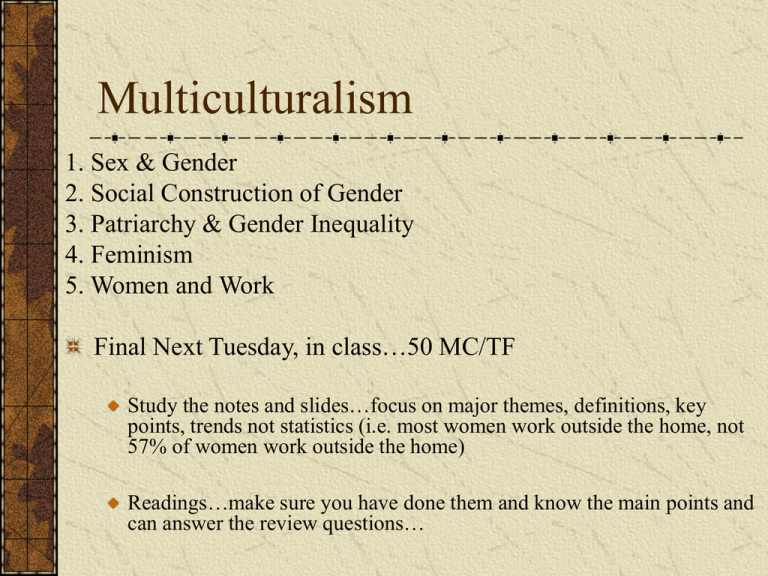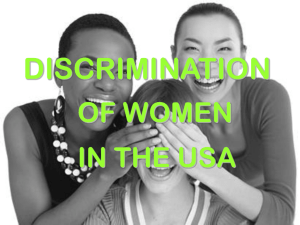Gender and Society - Widener University
advertisement

Multiculturalism 1. Sex & Gender 2. Social Construction of Gender 3. Patriarchy & Gender Inequality 4. Feminism 5. Women and Work Final Next Tuesday, in class…50 MC/TF Study the notes and slides…focus on major themes, definitions, key points, trends not statistics (i.e. most women work outside the home, not 57% of women work outside the home) Readings…make sure you have done them and know the main points and can answer the review questions… Quiz 1.Variations in gender roles (the way men and women behave) found in the many different societies studied by social scientists suggest that: A. gender roles are biologically determined B. gender roles are culturally determined C. gender roles are essentially the same everywhere, with only minor variations D. gender roles have been the same forever Quiz 2. By the late 1990s, the gap between men’s pay and women’s pay A. had virtually disappeared. Men and women’s pay is now basically equal B. remained, with women still earning less than men C. had been reversed, with women now earning more than men D. could no longer be measured since the census no longer asks people if they are men or women Quiz Bonus Point NYC Taxis… 2.Cabbies in New York City will not pick up Black men. When this occurs, a sociologist would note that Black men have experienced: A. B. C. D. Prejudice Discrimination Travelers neglect Social Construction Quiz 1.Variations in gender roles (the way men and women behave) found in the many different societies studied by social scientists suggest that: A. gender roles are biologically determined B. gender roles are culturally determined C. gender roles are essentially the same everywhere, with only minor variations D. gender roles have been the same forever Quiz 2. By the late 1990s, the gap between men’s pay and women’s pay A. B. C. D. had virtually disappeared. Men and women’s pay is now basically equal remained, with women still earning less than men had been reversed, with women now earning more than men could no longer be measured since the census no longer asks people if they are men or women Still a gap…glass half full…or half empty… In 2008, women who were full-time wage and salary workers had median weekly earnings of $638, or about 80 percent of the $798 median for their male counterparts. In 1979, the first year for which comparable earnings data are available, women earned about 62 percent as much as men. Bonus Point NYC Taxis… 2.Cabbies in New York City will not pick up Black men. When this occurs, a sociologist would note that Black men have experienced: A. B. C. D. Prejudice Discrimination Travelers neglect Social Construction Part 2. Discrimination the denial of opportunities and equal rights to individuals and groups because of prejudice or for other arbitrary reason (D) Not just an attitude, but an action Cabbies won’t pick up Black men Denny’s refuses to seat Black secret servicemen Landlords refuse to rent to minority residents Go to the corner of the room that matches your belief… In America today, whether a person is a man or woman no longer matters since American society treats everyone equally. http://www.bls.gov/cps/cpswom2004.pdf Women are 51% of Population…but as for Political Power? Sex vs. Gender What doe it mean to say “gender is a cultural, not a biological phenomenon?” Sex - refers to biological differences between women and men.(D) Women have two X chromosomes while men have an X & Y Men and women have different reproductive organs Gender - refers to psychological, social and cultural differences between women and men (D) Little girls play with dolls, boys play with tools Men are “rough,” women “dainty” Gender Born Male and Female BUT… We learn what it means to be a man or a woman “Gender is a cultural, not a biological, phenomenon.”(p.232) Gender Roles Vary Across Space & Time… Navajo Berdaches Anatomically men Marry other men who are not considered homosexuals Berdaches as a 3rd gender… • A role that doesn’t exist in US culture Dahomey people of West Africa: women formed the king's bodyguard because they were believed to be fiercer fighters than men. Gender Roles Vary Across Space and Time… America: 1850 vs. 1950 vs. 2000 America 2006 vs. Saudi Arabia 2006 Differences are stark In US we have women police officers, soldiers, pilots, construction workers, senators, boxers, basketball players, engineers, lawyers, etc …NOTHING BIOLOGICAL HAS CHANGED Gender “ Were differences between men and women determined by biological factors alone, we would not find the vast diversity that exists in gender relations from society to society; moreover, were sex differences universal in content, what it means to be a “man” or to be a “woman” would not vary from one culture to another.”(Anderson, p.23) What is the sociological term to describe the idea that things like race and gender role are not natural? Gender as a Social Construction Gender as a SOCIAL CONSTRUCTION Gender is created, lived & transformed by social actors embedded in certain historical circumstances “refers to the many different processes by which the expectations associated with being a boy (and later a man) or being a girl (and later a woman) are passed through society.” (Anderson, p.231) • Gender Roles are not rooted in nature…but in our culture • Process of construction begins at birth Blanket study Creating Gender… Organizational Rules and Laws Laws or Rules limiting the rights of girls & women • (i.e. no education, no vote, no right to own property) Laws prohibiting women from certain jobs • In US, organizational rules banned women from many occupations & colleges until 1960s Much of the world is still like this Cultural Beliefs and Attitudes Boys are athletic, girls are fragile • My mother in law… Boys get tool belts and guns, girls get dolls and ovens Biological thing called crying…girls are allowed to, boys can’t Girls urged to share feelings, boys must be stoic and tough Girls occupations and boys occupations • “I’m Glad I’m a boy, I’m Glad I’m a Girl” Gender & Society These laws and cultural attitudes lead to… Patriarchy male dominance in a society (D) Patriarchy leads to Gender inequality differences in the status, power and prestige women have in groups, collectives and societies.(D) It is not an exaggeration to say that until recently most men in the US thought a “woman’s place was in the home”… “barefoot and pregnant in the kitchen” Many men on the planet still feel this way Gender Inequality…in many spheres Violence Estimated 1.6 million women battered every year Estimated 430,000 sexual assaults Language He as generic for people • “all men are created equal” Bride takes Husband’s name Gender Inequality… School Curriculum 1992 Study of 631 page 6th Grade Text: Exploring our World, Past and Present 7 pages on issues relating to women Only one American adult women mentioned Susan B. Anthony not mentioned Only 11 females mentioned in whole book Clara Barton, Mother Jones, Rosa Parks, Mary Wollstonecroft, Jane Addams, Elizabeth Cady Stanton, Margaret Sanger, Betty Friedan… Video Clip Part1 Gender Inequality, Society and Work…Creating the present moment… 1) What are some examples of gender inequality seen in the video? Examples of ways women were treated as second class citizens? Video Clip Described Gender Segregation Working and Middle class women who did work outside the home experienced… Gender segregation- distribution of men and women into different jobs in the labor force (D) For most of US history, segregation was not just due to Cultural beliefs… • Male bosses think women are too meek to be miners They were due to Organizational rules and laws that narrowed options for women and segregated them into certain jobs • Company rule: “No women may perform the following jobs” Big Change…Rosie the Riveter Feminism the philosophy that men and women should be politically, economically, and socially equal. (D) Video Clip Part 2 Discrimination Becomes Illegal… Feminism the philosophy that men and women should be politically, economically, and socially equal. (D) Equal Pay Act of 1963 first federal law to require that men and women should receive equal pay for equal work (D) Civil Rights Act of 1964 banned employment discrimination based on race, sex, religion, color and national origin. (D) Multiculturalilsm 1. Women and Work 2. The Earnings Gap 3. Comparable Worth 4. Glass Ceiling 5. Second Shift Final on Tuesday, in class…50 MC/TF Study the notes and slides…focus on major themes, definitions, key points, trends not statistics (i.e. most women work outside the home, not 57% of women work) Readings…make sure you have done them and know the main points and can answer the review questions… Website is up to date…today’s slides will be put up later Women & Work Today How many of you had moms that worked? How many of the women in the class plan on pursuing a career? How many of you guys plan on staying home and raising a family? Women & Work Today Most Women Earn a Wage Interesting time for society…changing roles… challenges for society One challenge…caring for newborn babies…What to do? Challenging Times… Family Medical Leave Act permits 3 months off… but without pay. U.S. is one of only five countries out of 173 surveyed that does not guarantee some form of paid maternity leave The others are Lesotho, Liberia, Swaziland and Papua New Guinea. Examples of how other societies deal with situation France: Law provides up to 6 months with 85% pay Norway: Law provides1 yr with 80% pay Sweden: Law provides 1yr with full pay NJ just passed law giving 6 weeks with up to 2/3 pay Another challenge…pay still lags for women Gender Gap 1 yr after Graduation (PI April 24, 2007) 120 99 100 80 75 81 105 82 60 % Salary 40 20 0 Service Biz/man Res/Tech Med Engineer Income Gap by Education 70000 60000 50000 40000 Men Women 30000 20000 10000 0 HS BS/BA Masters Pay Even Lags for Female College Grads… A gap in pay between U.S. college-educated men and women starts soon after graduation and widens over time, according to a study released yesterday. One year after receiving degrees, women working full time already earned 20 percent less than men, a report from the American Association of University Women found. The difference grew to about 30 percent a decade after graduation. (Salaries for college-educated women lag those of men soon after graduation…The gap grows with time (PI 4/24/07) Explaining the gap… Anyone have a hypothesis to explain why women’s earnings lag those of men? Gender Segregation & Occupational Distribution Pay gap is in part due the fact that women are concentrated in low wage occupations The majority (55%) of women work in traditionally “female” occupations where wages have historically been low Clerical workers, sales clerks, or in service occupations such as maids, food service workers, health service workers, hairdressers and child care workers Let’s consider the concentration…and then the pay Occupational Concentration Percentage of Women in Select Occupations Secretaries Dental Hygienist 1983 99% 98.6 1998 98.4% 99.1 Pre/Kind Teacher Nurse Truck Driver Pilots 98.2 95.8 3.1 2.1 97.8 92.5 5.3 3.4 Carpenter Firefighter Auto Mechanic 1.4 1 .5 1.2 2.3 .8 Explaining the concentration…Why do women concentrate in these jobs? Past & Present Discrimination puts women in certain jobs People my mom’s age were overtly discriminated against…legally Women often face subtle and not so subtle discrimination in the labor market (Firefighters…electricians… “North Country”). Lack of role Models shapes what girls think they can do Linked to past & present job segregation • “All the women I knew were either teachers or nurses” Gender Socialization shapes what girls want to do Traditional gender role still linger • Boys get tools and trucks, girls get dolls and ovens Stereotypes Linger • Men are technical, women are nurturing • Men are leaders, women are submissive Why low pay in female documented occupations? “Women’s work” traditionally not valued by society Is a bus driver’s work worth twice a daycare worker’s… $11.56 $12.00 $10.00 $7.80 $8.00 $6.12 $6.38 $6.00 $4.00 $2.00 $0.00 Child Care Parking Lot PreSchool Bus Driver Percentage of women in occupation has net negative effect on earnings Even when controlling for level of education and skills • Teachers vs. other professionals Comparable worth…big issue in society… Idea that women and men should be paid equal wages for jobs that require comparable skill levels; sometimes referred to as pay equity. Secretary & Groundskeeper AFSCME v Washington State…Carpenter vs. Licensed Practical Nurse? Comparable worth…big issue in society…(This is in the reading) AFSCME v Washington State… Man works career as Licensed Practical Nurse • LPN needs 4yrs experience, 2 yrs school and license About to retire, realizes “women’s job” will not provide adequate pension”…transfers to carpentry department • Carpenter self taught, no experience, no license Makes more at bottom of carpenter scale than at top of LPN scale Court rules finds discrimination…Overturned by Court of Appeals…but Washington State agrees to address situation Occupational Concentration in low wage jobs contributes to pay gap Percentage of Women in Select Occupations Secretaries Dental Hygienist 1983 99% 98.6 1998 98.4% 99.1 Pre/Kind Teacher Nurse Truck Driver Pilots 98.2 95.8 3.1 2.1 97.8 92.5 5.3 3.4 Carpenter Firefighter Auto Mechanic 1.4 1 .5 1.2 2.3 .8 Women in the Professions…pattern? 45 40 35 30 Engineer Law/Jud Man Doc 25 20 15 10 5 0 1960 1980 1998 Women in Professions… There are More Women in Traditionally Male Jobs …glass half… 45 40 35 30 Engineer Law/Jud Man Doc 25 20 15 10 5 0 1960 1980 1998 There are More Women in Traditionally Male Jobs…BUT!!!!!!!!!!!!!!!!!!!!!!!! But earning gaps exist even within same occupations, even high paying occupations. Managers, Professors, Lawyers, Stockbrokers… Explaining the earnings gap? Earnings gap in part due to concentration…and due to lack of value given to women’s work… But earning gaps exist even within same occupations, even high paying occupations. Managers, Professors, Lawyers, Stockbrokers… Why? Any ideas? Why the Earnings Gap? Research shows that it is partly due to a wage penalty for motherhood Recent study finds 7% penalty per child Why do you think that this is? Why are mothers penalized? Having kids in a culture which pressures women to be the primary caregiver… Interrupts women’s employment, leading to breaks in career Results in fewer years of experience and less seniority Leads many to seek part time work Low pay, few benefits, often no career ladder Earnings Gap within Occupation But most of the gap is still a mystery? Lower productivity? Juggling work and family… Old Fashioned Employer discrimination? Merrill Lynch • “Systematic discrimination” was found • Favored men, paid them more, gave them better accounts, more promotions • “We agree, and regret, that nearly a decade ago there was inappropriate behavior in the San Antonio office. It should not have occurred and would not be tolerated today." Explaining the Earnings Gap Women do not rise to the highest levels of their occupations and thus earnings gap emerge Glass Ceiling A promotion barrier that prevents a woman’s upward mobility within an organization • Approximately 90% of top executives are men A Glass Ceiling? A promotion barrier that prevents a woman’s upward mobility within an organization Approximately 90% of top executives are men So why do women hit a glass ceiling? A Glass Ceiling? A promotion barrier that prevents a woman’s upward mobility within an organization Approximately 90% of top executives are men Why? Legacy of past discrimination • If women were not hired until 1970s, there will simply be fewer in the cue for upper management Persistent Stereotypes • Women can’t lead…men won’t follow • Women not as committed to careers (see slide) A Glass Ceiling? Why? Legacy of past discrimination • If women were not hired until 1970s, there will simply be fewer in the cue for upper management Persistent Stereotypes • Women can’t lead…men won’t follow • Women not as committed to careers Discrimination • “People like people like themselves”…most upper management is white and male… • Fewer Networks, mentors… A Glass Ceiling? A promotion barrier that prevents a woman’s upward mobility within an organization Approximately 90% of top executives are men Why? Legacy of past discrimination • If women were not hired until 1970s, there will simply be fewer in the cue for upper management Persistent Stereotypes • Women can’t lead…men won’t follow Discrimination • “People like people like themselves” • Fewer Networks Second Shift…what’s this? In Two earner homes, “Who has more responsibility for housework…” 100 90 80 70 60 50 40 30 20 10 0 Men Women Shop Cook Clean Bills Repair Second Shift? Second shift- refers to employed mothers who do two jobs. A full day of paid employment plus the work at home (D) Men do about 20% of the housework Employed mothers now work an average of 66 to 89 hours a week counting paid labor, housework, and child care. Division of Labor at Home effects work life…again, note comic Women, wages and poverty… Feminization of poverty refers to the increasing proportion of the poor who are women and children. 60 50 40 30 Percent of all poor families maintained by women alone More female headed households • Divorce…no marriage Pov 20 10 0 1959 1946 1997 Women… Feminization of povertyrefers to the increasing proportion of the poor who are women and children. 35 30 25 20 More female headed households • Divorce…no marriage 1973 1997 15 10 5 “Deadbeat Dads” • Percent of Moms getting child support from Dads Lower wages for women…next slide 0 Single Mom Never Married Low Wages lead to poverty… “If men and women were paid equally, more than 50 percent of low-income households across the country--dual-earner as well as singlemother--would rise above the poverty line.”(Barko, p.1) Gender Equality What could improve the situation of women? Changing cultural norms? Just need to wait…will take time? More Affirmative Action? Firm goals and timetables…Must have 30% female managers by 2015 New public policies? Credit for time off? Flexible Scheduling? More enforcement of anti-discrimination laws? Comparable worth legislation? Multiculturalism Multicultural courses emerge that begin to incorporate the previously “invisible” subjects into the curriculum Inequality and Class Immigration Race and Ethnicity Gender Brief introduction to these topics as they are taught in college… You can take semester long courses on most of these topics…






